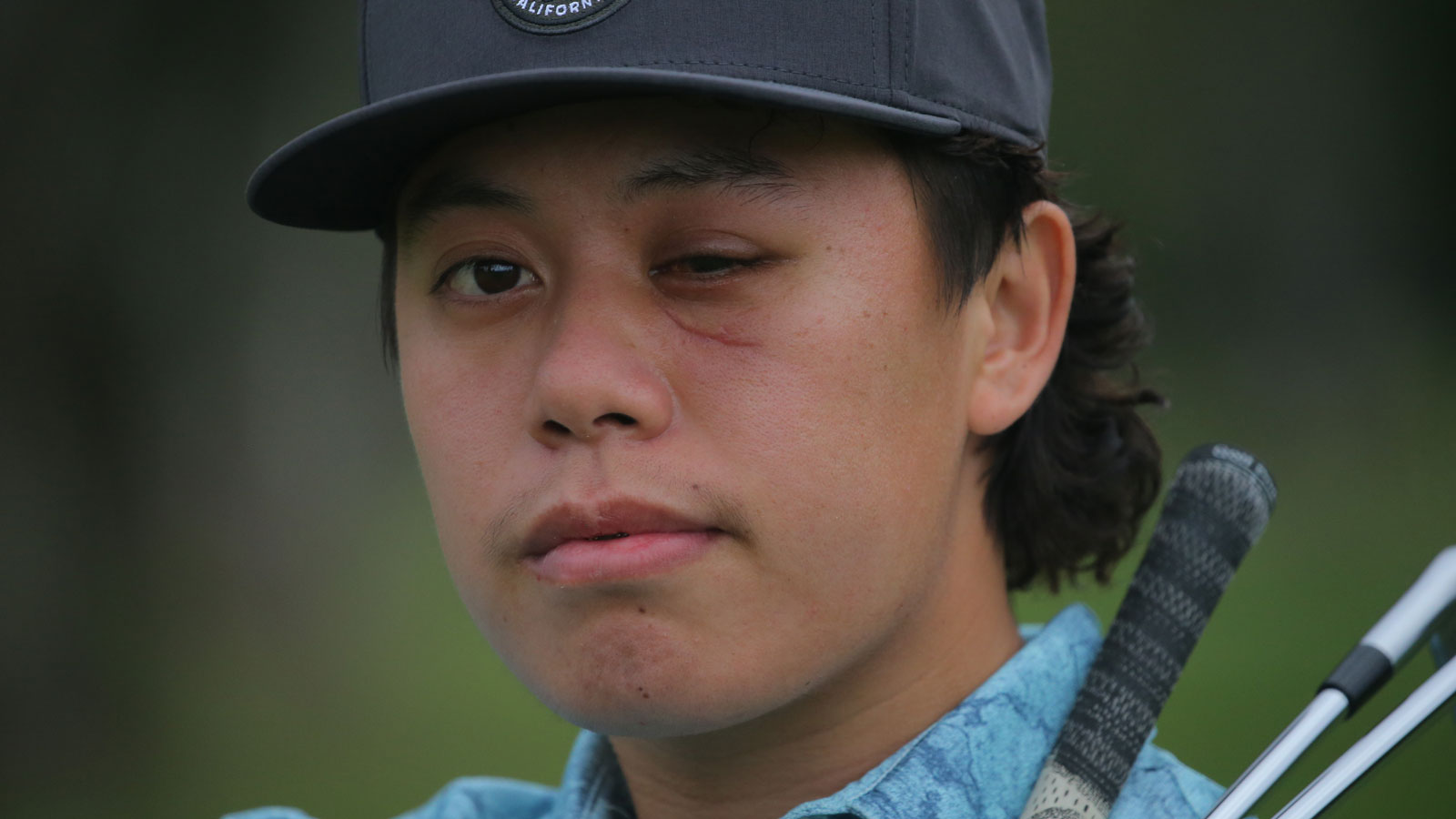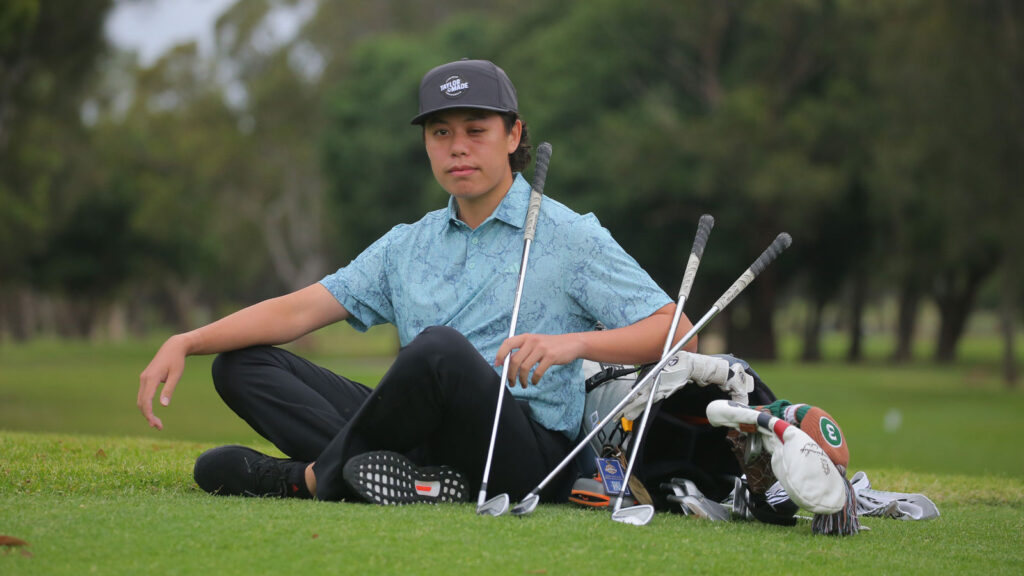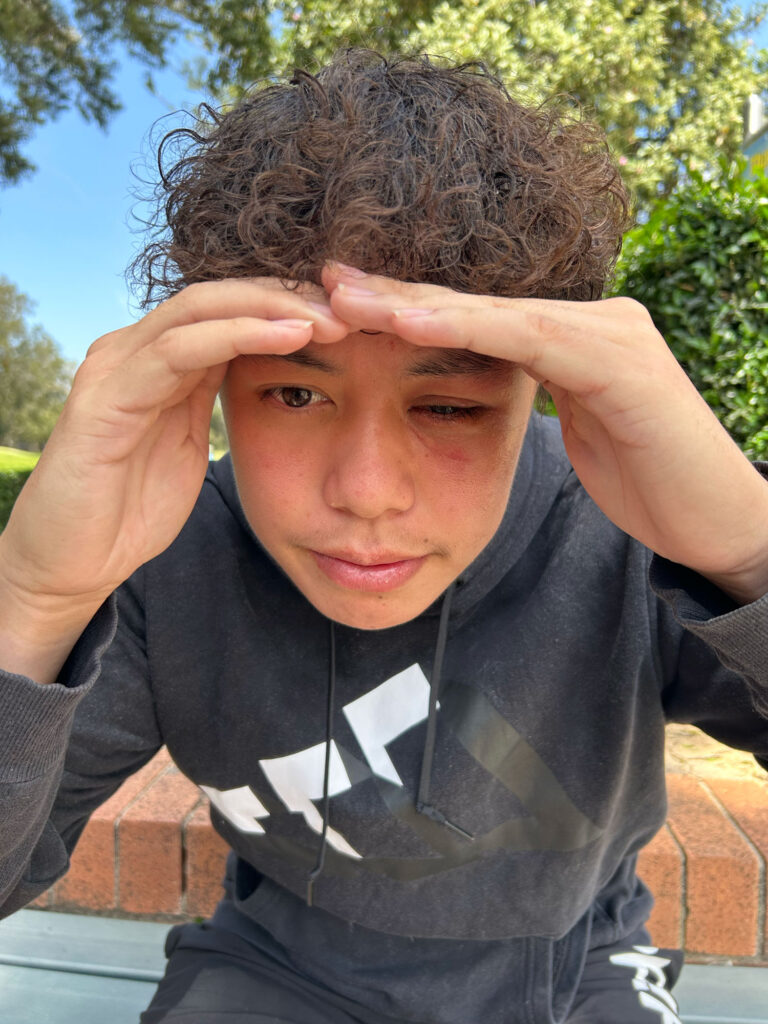‘ALL I CAN SEE IS BLACK’: Jeffrey Guan details long journey ahead in first interview since horrific eye injury – Australian Golf Digest

- by Admin
- October 31, 2024

[PHOTO: David Tease/Golf NSW]
It’s a particularly bright, sunny Tuesday morning outside the Beverley Park Golf Club pro shop in the southern suburbs of Sydney.
The songbirds are in tune, as are the opening tee shots struck by local members in front of us. It’s a serene setting for golf, enticing us to have a hit of our own. Only the guy standing next to me – 20-year-old golf phenom Jeffrey Guan – can’t play today, as much as he’s itching to.
To get a quick snapshot of his life right now and for the immediate future, I get Guan to cover his right eye with the palm of his hand and look towards the first tee.
“Tell me what you see, Jeff?” I ask.
“Nothing. It’s just black. All I can see is black,” replies Guan, removing his hand so he can regain his bearings.
Guan has no vision in his left eye. Zero. How long that lasts will be in the hands of the gods – and medical science – but doctors have told him it will be a miracle if he regains anything of substance.
Truth is, Guan is lucky to still have his eyeball intact after a freak accident during the pro-am of a New South Wales Open qualifying event on the NSW South Coast in September. Six holes into his round, Guan was struck by an errant golf ball at Catalina Club while putting a club back in his bag. What happened next remains a blur, figurately and literally, for the kid many tipped to be the country’s next Cam Smith.
“The instant ringing and pain rushed to my head, and I dropped to the ground,” Guan recalls. “Voices sounded pretty muffled and the next thing I knew, I was in an ambulance being transported to hospital.”
Over the ensuing hours and days, Guan was operated on several times, transferred from Moruya to Canberra and finally to the Sydney Eye Hospital, where some of the world’s leading vitreoretinal surgeons worked on saving his eye after the force of the blow rendered him with multiple fractures to the eye socket and “catastrophic” trauma to the eyeball.
Guan won’t know the final outcome of that traumatic day for at least another six months, as his long and very considered rehabilitation program plays out.
Such horrendous luck, of course, should never be wished upon anyone. Yet what makes Guan’s traumatic tale particularly hard to accept right now is where he was heading in the world of professional golf. Just one week prior to making that fateful drive to Batemans Bay, Guan was “California Dreamin’” in America’s iconic Napa Valley, making his PGA Tour debut at the Procore Championship. He’d just signed with Sportfive, the same sporting agency as golf megastar Jon Rahm and had the world at his feet. All those years of unrelenting hard work and commitment, from a young Guan catching buses and trains to the golf course with his clubs, to the sacrifice made by his parents, who to this day make ends meet in a kitchen and by driving taxis, to Guan still sharing a bunk bed with his younger brother… this family’s fortune looked set to change on the account of him becoming a worldwide name in golf.
Then WHACK!
A walking, talking example of how fickle life can be.
Incredibly, throughout it all, Guan has remained buoyant and focused on getting back out on the course and becoming an even better player than he was prior to the accident. He knows it’s a long road ahead, but he’s extra-determined to overcome the hurdles in his way, be it with vision in two eyes or one.
“As a kid, I have always had a lot of perseverance and persistence,” he says. “I have no doubt that I will continue to do my absolute best to work hard and achieve my dream. I can confidently say that I have reached an even stronger level, mentally, and I will be ready to conquer any obstacles down the road.”
In this exclusive interview, Guan delves deeper into the highs and lows of the past few months, what he’s doing to stay in the game and why the legendary Tommy Armour might be his new favourite player to study.
IMAGE: Brad Clifton
AUSTRALIAN GOLF DIGEST: Jeff, one week you’re in America living the dream, the next you’re in regional New South Wales playing a pro-am and the unthinkable happens. What were you doing back here?
JEFF GUAN: Well, [Club Catalina] was going to be one of three pro-ams I was playing to keep my game in check. I was planning to play three of them in a row, take a week off over the [World] Sand Greens Championships, then fly over to Western Australia for the WA Open before playing the entire Aussie summer after that. That was the plan, anyway.
Then came the incident heard all around the country. What do you remember?
My playing partner and I shared a cart and we both hit our drives down the right side of the fairway. He didn’t hit it as far as everyone else, so obviously he played his next shot first. After he hit his next shot, he put his club back in his bag. As we approached my ball there was no one beside me on my side of the fairway, so I figured it was my turn to hit. I took, maybe, 45 seconds to hit my shot and then, as I turned around to put my club back in my bag on the cart, that’s when a ball hit me in the eye, and I fell to the ground. The next thing I knew, the ambulance was there attending to me.
Were you knocked out or just in a bit of a daze?
I was conscious but it was very, very hard to tell for me. Voices were really muffled and I just couldn’t really hear much. I heard people asking me if I was OK, but it was just very faint. I felt a pain on top of the left side of my head and I had no idea where it hit me. As I fell to the ground, I remember I just saw blood coming out of my eye and then the next thing I know, I had a towel over my head. Everyone was telling me, “It’s OK, the ambulance is coming,” and then I was in an ambulance enroute to [Moruya] Hospital.
Then, from there, you were stabilised and airlifted to Canberra?
Yes. So, they just got me checked in and gave me a high dosage of drugs and then they airlifted me to Canberra where I had my first surgery.

IMAGE: David Tease/Golf NSW
That must have been a horrible experience to have to go through all on your own?
Honestly, the pain was just so much. I was just trying to get through that. There was not much else I could really think about. It just hurt so much around the eye and then obviously I had a patch over it as well, so I didn’t know what was going on. I kept telling myself, My parents are going to be here soon. I had spoken to them earlier, so I knew I just had to hang in there for an hour or so until they got there.
Were you tempted to look at the damage of your eye at all – to get some sort of idea why you were there and what had happened?
I couldn’t move. I just felt like it was taking such a big toll on my body to even just move an arm. If I needed to wipe something on my face, it was just so difficult. Plus, I didn’t want to make things even worse, so I just waited there on the bed and just asked for water whenever I could get it.
In that moment, are you thinking about anything other than your injury? Did you allow your mind to wander into your immediate playing future at all?
No, not at all. I would say most people would probably think the same thing. First thing’s first – I just wanted my family to be there. And then the second thing was obviously for myself to get better. I had no intention of thinking about golf at all.
Due to the pressure dangers of flying, you were then driven to Sydney for further treatment. That must have felt like the longest drive of your life, not knowing the full extent of damage to your eye?
Yeah, critical time was passing for the best possible treatment to save my eyeball and sight, so we knew we had to make some quick decisions around getting to Sydney Eye Hospital to see the specialists.
You’ve obviously come to terms with whatever the outcome’s going to be from a vision impairment point-of-view. How have you managed to get yourself in that place, mentally and emotionally, so quickly after the accident?
I have received a huge amount of support from everyone. But I think hearing experiences from other athletes that have also made themselves a career with other injuries, injuries that could have been more severe than mine, has also given me that thought of, I can still make it, and, I can still practise and try to be even better than I was before. I think I’ve always had that mindset as a kid. I just want to be better, I just want to be the best, and that’s basically it. Even though it was a tough time to get through, I feel like I still had that motivation to get back out there and try to play on the biggest tours and play my best golf.

IMAGE: Brad Clifton
Before returning to the fairways there are going to be several challenges for you to overcome, but I would imagine depth perception would be a big one. Have you given thought to how you’ll tackle that?
Yeah, I’ll definitely need to start doing exercises to improve my depth perception. Basic stuff initially, like picking things up from the table and then looking at objects from different points. Just moving around to see where the object is. I haven’t even hit a golf shot since the incident, right? I’ve hit a couple of putts and it was definitely a different experience [laughs], but I think the technique and the way you hit the golf ball are still sort of there, so I don’t think too much will be changed except the fact that the depth perception is going to be slightly off. I really won’t know until I have experience hitting the golf ball again, but I have to wait for the doctor to give me the all-clear to do that.
Be honest – that first putt you hit, it went in didn’t it?
It did, yeah [laughs].
Have you been given a timeline on exactly when you will know the full extent of the damage and what you’ll have to deal with long-term?
They gave me a rough estimate from six months to a year. That’s how long the injury will take to settle down and sort itself out. But six months is the earliest I can get slowly get back into full practice and where everything could be back to the new normal and things are more stable. I mean, obviously the chance is still there to lose the eyeball, but obviously it’s going to be very minimal, mainly because throughout this little period when it’s been stable, that’s going to help it repair and grow stronger over the next six months.
What are you going to do to fill your days during this recovery period?
I contacted the PGA of Australia and Golf Australia and I’m actually going to start a coaching course that will allow me to work at my own pace. I think the entire course might be, like, two-and-a-half to three years. But if I just do the first year, then at least I get that done and I have something to do within that time. I also like playing video games, so that takes up a little bit of time [laughs].
How are the current pain levels? Improving by the day?
Yeah, at the hospital it was tough. I had antibiotics every eight hours. I had to take painkillers every four hours, so my sleep was always interrupted. I was on the heavy stuff too, like Endone (Oxycodone), which still wasn’t really helping in the first week. But as time went by, it’s been a lot better. As soon as I was released from hospital, I was still feeling a little bit of pain sleeping. I still have to wear an eye shield to sleep at night, just in case it gets itchy and I feel the urge to scratch it. Or if I sleep on my left side, I can’t really have that pressure on that eye either. But it’s getting a lot better.
OK, let’s shift and get to the career highlight. Tell us about your PGA Tour debut. How cool was that?
Yeah, it’s always been a dream of mine to play one of those events and the setup was just amazing. I got my start in the Procore Championship courtesy of an invite from my agents at Sportfive and it was just everything I dreamed of and more. I got a call-up on the Saturday night and flew out Sunday morning for that tournament. It was definitely a big change, but I loved every bit of it.
Did you seek out any players for advice or did anyone in the field go out of their way to welcome you?
Yeah, Min Woo Lee was great and went out of his way to make me feel comfortable before the tournament teed off. I saw a couple of the amateurs that I played with growing up. I played a practice round with [Chinese prodigy] Wenyi Ding. He’s obviously just turned pro and has big expectations on him. And then there’s Nick Hardy, who shares the same coach as me (The Australian Golf Club-based Gary Barter). I saw him on the range, so he wished me good luck for the week. Everything was so perfect. Not a blade of grass was out of line, and everything was so pure, especially the greens. I was putting on cored greens for three weeks leading into the tournament and then, all of a sudden, I’m putting on greens rolling at 13 [on the Stimpmeter] [laughs].
• FOR THE FULL INTERVIEW, GRAB YOUR COPY OF AUSTRALIAN GOLF DIGEST‘S DECEMBER ISSUE – ON-SALE NOVEMBER 28. SUBSCRIBE HERE
SHOW YOUR SUPPORT FOR JEFF
The Australian Sports Foundation has created a donation page for those who wish to support Jeff Guan financially in his recovery and journey back to elite-level golf. To contribute, please visit asf.org.au/projects/jeffrey-guan/support-for-jeffrey-guan or e-mail Duncan Reid at [email protected] for additional ways to help.
The Latest News
-
January 2, 2025How late bloomer ‘slammed down the door’ for Test debut
-
January 2, 2025PGA Tour expands ways college golfers can earn points toward PGA Tour cards – Australian Golf Digest
-
January 2, 2025Lexi Thompson rings in 2025 by getting engaged – Australian Golf Digest
-
January 2, 2025Australia vs India, fifth Test at SCG, live cricket scores 2025: Day 1 live updates and blog, scorecard, teams, Beau Webster debut, latest news
-
January 2, 2025Australia’s China studies sector once led the world, but is now ‘in crisis’





